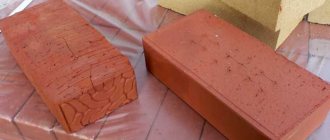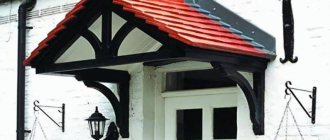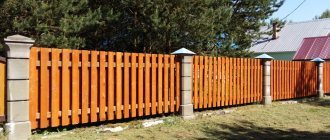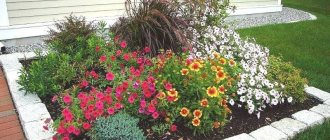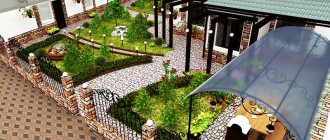You should not be negligent about the strength characteristics of this structure - the durability of the fence is important, since this is not an interior decoration that can be altered according to your mood. Capitally built from quality materials, a fence is a sound investment and will provide years of worry-free construction.
There are a great variety of materials for fencing on the market today: from the most budget-friendly to expensive and downright pretentious options. Each of them has its own service life, naturally.
If we talk about natural stone, this material has earned its title as one of the most durable for centuries. The stone buildings, ditches, and masonry fences that were built thousands of years ago have been perfectly preserved to this day! This says a lot, if not everything.
Currently, fences made of natural stone are prestigious, beautiful, reliable and very popular. Let's figure out what kind of fence can be built from stone, what kind of rocks are used for this, what their advantages are, and maybe we will find some disadvantages.
What is a natural stone fence and what types does it come in?
Natural stone has long been used for masonry of any structures. In particular, you can make a fence out of it. For this you will need:
- Stone - its consumption will depend on the model and area of the fence, as well as on the size of the stones themselves.
- The foundation for the structure must be solid, concreted and of high quality. This is important, since a flimsy or uneven support will simply lead to rapid subsidence and destruction of the masonry.
- Support pillars. A stone fence rests on a foundation from the ground, but along its length it must have appropriate, strong supports that support it, preventing the formation of cracks and collapses.
Despite the fact that, in fact, the same material is used in construction - stone, fence models are quite diverse and you can always choose among them the one that is suitable for each specific site.
Cost of installing brick pillars
| Height/width mm | Price | |||
| 1800/380 | 15 400 ₽ | ORDER | ||
| 2000/380 | 17 500 ₽ | ORDER | ||
| 2200/380 | 19 000 ₽ | ORDER | ||
| 2500/380 | 22 000 ₽ | ORDER | ||
*Low prices and regular discounts are due to our own production and the absence of intermediaries.
You can find out the cost of a brick fence post by phone in advance. Each structure is considered prefabricated, the price is set individually. Its cost depends on the type and quantity of material, volume of work. A company representative will help with calculations, which will save money.
Types of stone fences
- Solid
Here everything is clear from the name - solid masonry, of a given height - a fence that is too high in this case will seem too inaccessible, it is better to choose the option of a solid fence slightly taller than human height, that is, around two meters or so.
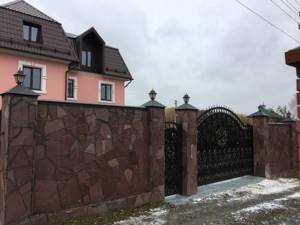
Solid fencing is easier to construct, but is often more expensive due to the higher consumption of expensive material. In addition, a solid stone fence may not be very convenient due to its absolute invisibility.
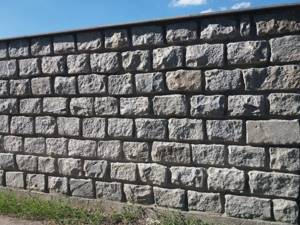
- Not solid, with gaps
Also named for its appearance - here areas of dense stonework alternate with gaps, that is, places in which the territory of the household is visible, and from the yard you can see what is happening outside its borders. This fence model looks more attractive; the gaps make the structure lighter and make the area visually larger.
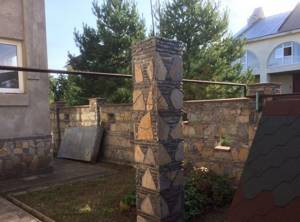
Such fences can be of very different heights and lengths - this will depend on the size of the site and the height of the building located on it. The option of a fence with gaps is more economical compared to a solid one, and the complexity of execution will depend directly on the client’s imagination.
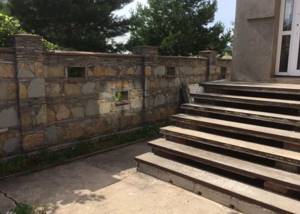
- Combined
In this case, it is proposed to combine natural stone with other building materials. It can be wood, metal, brick, concrete and even plastic.
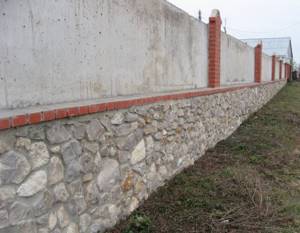
Such fences, made in compliance with the correct proportions and harmonious combinations, will look no worse than a solid stone fence, but at the same time, will be much cheaper in terms of the cost of materials and complexity of execution.
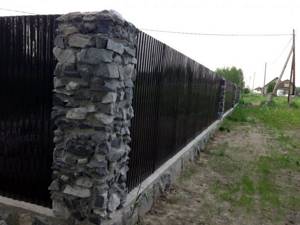
It is important not to be afraid to experiment and think through all the nuances before starting construction - then you will definitely get an unusual, beautiful, durable and not too expensive fence.
- Gabions
A unique type of construction, which is also successfully used for constructing stone fences. Gabion literally translates as a cage or basket, respectively, and the fence model looks like a cage (or, more simply, a mesh) made of metal wire, tightly filled with stones.
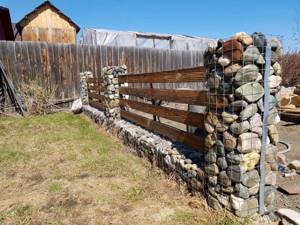
Gabions are used both in fencing private property and in landscaping river lands and park areas.
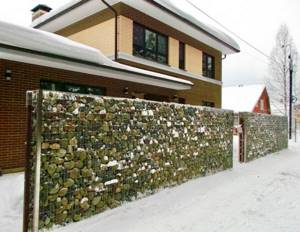
Each type of stone fence is good in its own way; in any case, if it is well made, then the strength of the structure will not be in doubt. Natural stone was, is and remains a durable and attractive building material. Its place in the construction market is firmly established, and the stone is popular at all times.
What are the advantages of brick fences?
To understand what the advantages of a brick fence are, let’s look in more detail at the features of such structures.
Brick fences fit organically into the landscape of suburban areas.
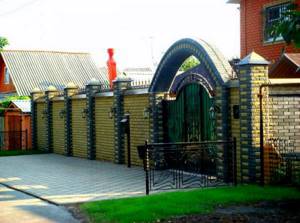
Brick fences for a private house, photo
Safety
Fences created on the basis of brickwork and having a rigid base provide maximum security for the garden area. Decorative structures have a lower level of security, but they do an excellent job with their purpose on the estate.
On a note! Although decorative brick fences lack security, they look very presentable; Such hedges are great for implementing original design ideas.
Degree of reliability
The reliability indicator depends on the density of the brickwork and base. A fence one brick thick can withstand the tangential mechanical impact of a machine impact.

In terms of strength, a brick fence is considered one of the strongest. A fence of one and a half brick elements will withstand the impact of a loaded vehicle. And the thickness of three bricks will make the fence resistant to any influences.
Brick fences fit perfectly into Mediterranean-style landscape decor. Such fences can perform both practical and aesthetic functions.
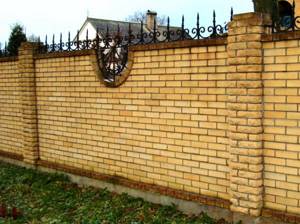
Life time
A brick fence built in accordance with technical specifications can last for several decades without losing its original performance qualities and appearance.
Find out how to properly build a fence from gabions with your own hands: step-by-step construction instructions, ideas and placement options, subtleties of use in landscape design.
Photos of original fences made from plastic bottles can be seen in this article.
Decorative qualities
Modern building materials and techniques make it possible to build fences for a private home that perform not only protective functions, but are also original decorative structures, with a transition of colors, with a variety of cladding and design. You can choose an option from photos, in photo galleries, or even by accidentally photographing someone else’s fence you like while on a walk.
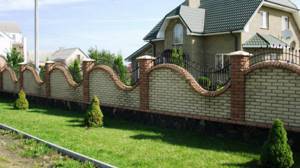
Recommendation: if you want to create a brick fence with an unusual design, use bricks of different colors to build it.
Additional benefit
Fences made of brickwork can be used as a base for creating lighting in the garden area, as a reliable support for creeper plants. Such structures are also used for fastening various household appliances.
On a note! Plant flowering shrubs, such as jasmine, near a brick fence, and the fence will immediately be transformed.

Which fence stone do you prefer?
Stone is one of the most durable natural materials found in nature. However, it must be taken into account that two stones differ from stone to stone. Naturally, there can be many varieties of this material, but the most common types of stone for construction, including fences, are:
Granite
Surely everyone is known for its high hardness. Unfortunately, because of this, building fences from granite is a more complex process than from any other rock - granite is difficult to process and requires special tools and equipment.
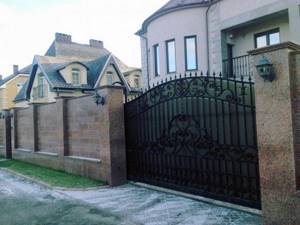
But on the other hand, this stone has a high natural attractiveness, a variety of pleasant colors and a stylish rough structure. Naturally, the price of granite itself and work performed from it will be higher than other analogues. Granite fence is rightfully considered the most expensive, which also plays an important role in the average popularity of this breed among consumers.
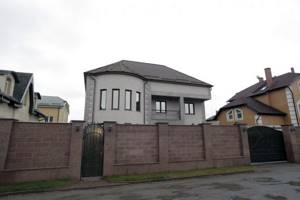
Dolomite
Also durable and wear-resistant material. This type of stone is mined in mines using the rock explosion method - that is, it is able to withstand significant mechanical loads and difficult atmospheric conditions. Before sale, dolomite is processed with special grinding wheels. As a result, its appearance is brought to flat elements of various shapes, sizes and thicknesses. Dolomite is attractive because it can be used to make geometrically attractive fences, with spectacular jointing on the masonry.

Cobblestone
This is a general name that more characterizes the shape of the stones. In fact, cobblestones come from a variety of natural rocks: sandstone, limestone, slate, and several others. For fences, beautiful shades of rocks are often selected - in red, brown or burgundy tones - colored stones look visually interesting. There are, however, those who want to have a fence made of gray or almost black cobblestones.
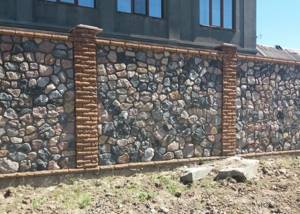
As a rule, to build fences, cobblestones are used, one of which has a flat side. Masonry experts know how to break cobblestones with a sledgehammer in such a way as to obtain two or three flat-sided elements from one stone. When working with this material, it is important to follow safety precautions and protect others from possible injury, and property from damage.
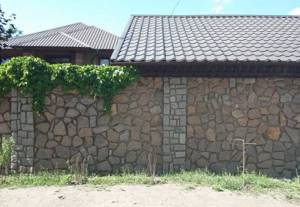
Limestone
A well-known and widespread breed. There are several types of limestone, they differ in appearance, however, they have similar properties. This is not an expensive natural stone compared to other rocks, however, it is also the least durable. On the one hand, it is convenient because working with it is easy and accessible even to self-taught people, and on the other hand, in conditions of high humidity, limestone will fail earlier than other natural stones.
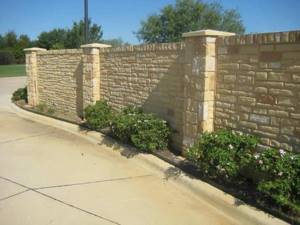
This is due to its ability to absorb moisture and, when saturated, to collapse. Of course, limestone is still used as a building material, but this feature must be taken into account when planning the construction of a fence from it. It may be better to use this breed for finishing work or partially.
Sandstone
Natural stone is also not particularly durable, but at the same time it is used in construction often and everywhere - both for the construction of buildings and structures, and fences. The secret of successful operation is simple - sandstone is treated with special strengthening solutions, which significantly increases its performance properties.

This type of stone is quite simple to work with, and its price is reasonable - the combination of all these factors is what makes sandstone such a popular building material.
Shell rock
It has been known as a construction material for a long time, and has been successfully used for thousands of years. The structure of shell rock is loose and porous, the stone is soft and at the same time quite durable. You can also work additionally on the safety margin of this stone - then a building made from it will withstand all mechanical and atmospheric damage.
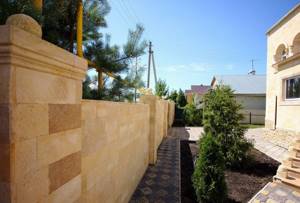
There are special solutions for treating shell rock used in areas with high humidity; you can additionally purchase a composition to protect the stone from microorganisms, moss, fungi and similar destroyers. If we are talking about exploitation in an urban region, then a successful solution would be to treat shell rock for the construction of a fence with protection from the effects of acids, alkalis, and other harmful chemical elements.
Gravel and pebbles
These small types of stones are also used for the construction of fences, however, quite rarely. Due to their size, they are difficult to work with and the construction process can be quite lengthy and labor-intensive. In addition, to prevent the collapse of such a fence, it is recommended to additionally lay the corners, base and cornices with brick or other type of material that can strengthen the entire structure.
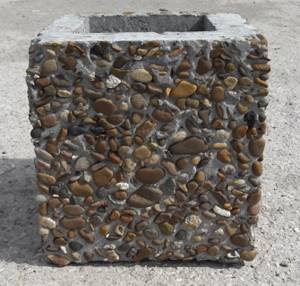
Main stages of construction of a combined fence
Beauty requires sacrifice. In the context of our topic, this means that you need to spend a lot of money and effort to create a really beautiful fence with brick pillars. To perform masonry, you will need to find a specialist who has great professionalism. The appearance of the entire fence depends on the quality of the masonry, so in this case you should not skimp.
The construction of the fence begins after the developer has completely decided for himself what material he will use and what dimensions the structure will have.
Preparatory work
The construction itself takes place in several stages and begins with preparatory work:
- If you want to make a really high-quality, beautiful and unique fence, then you should order its design from a specialist. He will perform all the necessary calculations, including determining the depth of the foundation and its thickness, strengthening the columns, as well as their number and other technological nuances. He can also carry out construction cost estimates. In this case, reinsurance guarantees high-quality performance of all subsequent work.
- The construction itself should begin with horizontal markings on the ground of the construction site. This is done using ordinary pegs and a long rope. It is stretched from the outside of the future foundation.
- Since a brick fence is a solid structure, the foundation for it also needs to be made permanent. A strip monolithic foundation copes with this role better than others. For it, they dig a trench along the marking line with a cord. Its depth should be 30 cm, but no less than the depth of the fertile soil layer, which should be removed to clay or dense soil. The width of the foundation, as well as the height above the ground, will be 20 cm. Then mark the location of the columns. They need to be done at equal distances. At the same time, try to calculate the gaps between the pillars so that there is as little residue from the filling material as possible. In places where the posts will be located, it is necessary to drill holes of 1.5 m or more. The depth depends on how deep the soil freezes in your area in winter. The diameter of the holes must be such that they can accommodate pipes of at least 60 mm in diameter.
- After completing the excavation work, formwork is constructed from edged boards, which is firmly fixed with bars. Reinforcement is laid inside the formwork in three rows, the cross-section of which should be 10 - 12 mm.
- We install pipes absolutely vertically in the outer holes. Using a building level and plumb line will help with this. They are concreted with concrete mortar. When the concrete has set firmly enough, a cord is pulled between the pipes. This is done to maintain the alignment of the remaining columns. Along this cord, maintaining verticality, the remaining pipes are installed and concreted. It should be remembered that if the soil on your site is loose or heaving, then a metal plate must be welded to the bottom of each pipe. Therefore, the diameter of the drilled holes must take this circumstance into account.
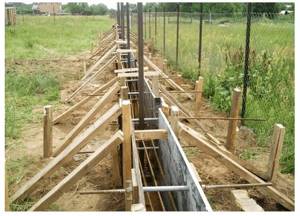
Foundation formwork for a brick fence prepared for pouring
- After the concrete under the pipes has set sufficiently, they begin to pour the entire remaining foundation. The solution can be ordered ready-made, or you can make it yourself in a concrete mixer. The same proportions are used as for any other foundation: 1 part cement, 3 parts sand. Medium-fraction crushed stone should be used as filler.
- After a week, when the concrete has completely hardened, it will be possible to begin making brickwork. However, a layer of mastic waterproofing is first applied to the foundation. This must be done, since dampness from the soil can destroy the brick over time.
Masonry work
Brick columns are laid out on a concrete base, 40 cm wide, which is done simultaneously with the pouring of the foundation around the column. The width of the column is 1.5 or 2 bricks. This depends on the type of masonry chosen. The most popular claque is 1.5 bricks, when one row takes 4 pieces. The bricks are laid on cement mortar with mandatory jointing. The rows are made symmetrically on all adjacent posts so that the seams between the bricks form uniform lines along the entire fence. The height of the columns depends on the material that was chosen for filling. They should be slightly higher than, for example, profile sheets. Mortar is poured into the middle between the bricks for strength. In addition, in two places on both sides of each column, a metal corner is brought out for welding the veins later, or they are immediately welded to the pipes, after which they are covered with brick.
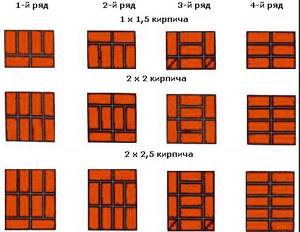
Types of masonry for columns
Filling the fence with corrugated sheets
You can use a profile pipe as jumpers between the pillars. When using a profiled sheet and a fence height of no more than 2 meters, two veins between the posts will be sufficient. They are welded to the embedded elements on the posts. Pipes and especially welds must be well primed and painted.
For the fence, corrugated sheeting with a thickness of 0.5 mm is suitable. They are secured to the joists with roofing screws or rivets. In this case, you need to ensure that the top edge is parallel to the horizon. It is worth noting that even the most budget option for a combined metal profile fence is quite expensive. However, anyone who wants to have a beautiful and reliable fence for a relatively affordable amount can take advantage of this opportunity.
In any case, a fence with brick pillars, built once, will serve faithfully throughout your life without reconstruction or repair.
Classification by type of stone processing for fence
Natural stones are extracted from rocks and, accordingly, are sorted by type of degree of processing. There are three main types:
- Rude,
- Average,
- Polished.
Rough stone needs pre-processing at the construction site - it is lightly trimmed, smoothing out sharp corners. Laying with rough-cut stone is a long and rather problematic process due to the selection of elements that match each other. In terms of price, of course, this type of processing will be the most budget-friendly.
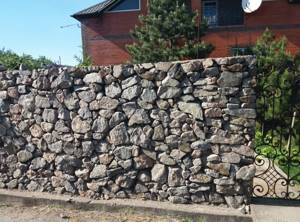
Medium-cut stone is most often used for the construction of fences - it is this type of processing that has the golden mean in terms of “price - quality”. Beautiful masonry made from it, of course, is available only to specialists, but in terms of work it is simpler than rough ones. At the place of installation it is enough to only lightly polish it.

Polished natural stone is the most expensive of this segment of building materials, this is natural - as it is due to its type of processing. After extraction, such stone is sorted by approximate size and carefully polished using grinding equipment. Its appearance is most attractive and it does not require any additional processing.

Fences made of polished stone are quite rare, since the cost of such a structure will be decent. Finishing or partial masonry made of polished stone is more common. Visually, a fence made of this type of material looks even and smooth, and goes well with forged and other decorative elements.
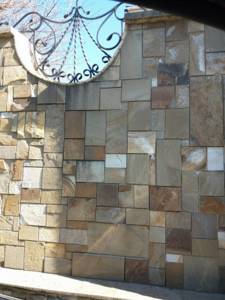
Principle of masonry
The main elements of any stone fence are: a foundation, a wall built directly from stone and reinforcing pillars, which can also be made of stone or other material. Often, when building a stone fence, a base of varying heights is formed on it, but extending along the entire length of the structure from the ground surface, and a cornice crowning the stone structure on top. These elements further strengthen the building and at the same time can decorate it.
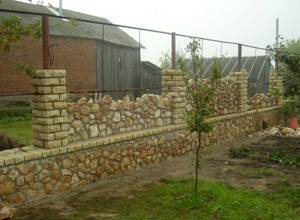
When planning a fence made of natural stone, be sure to take into account the landscape of the area - whether it is flat or hilly, you may need to prepare the soil for construction in advance.
Modern construction companies also offer a significant reduction in the cost of masonry: making the base of the fence from brick or similar material, and the exterior finishing from natural stone. This fencing option will cost much less, but, of course, will not be able to compare in durability with full-fledged natural stone masonry.
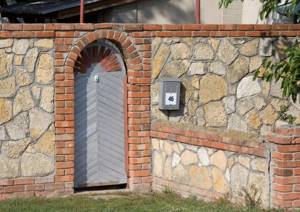
In any case, no matter what choice you make, take care to involve highly qualified specialists in the construction work, since no matter what kind of stone the fence is built from, it is the accuracy and correct execution technique that primarily affects its appearance, strength and durability.



